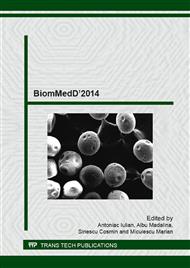p.104
p.111
p.117
p.123
p.130
p.135
p.141
p.145
p.151
Analysis of Centromedullary Nailing with Implant Failure
Abstract:
Centromedullary nailing is the most preferred surgical technique for the treatment of lower limb fractures and sometimes also on the upper extremity. It is a minimal invasive surgical intervention used mainly for long bones fractures that permits treatment without opening the fracture site thus preserving the local vascularization. With the improved knowledge and understanding of the fracture pattern and of the implantation technique good stability and rapid bone healing is obtained.We present a study on 8 patients with long bones fractures (femur, tibia, humerus) that were surgically treated with intramedullary nailing which failed due to non-union. Implant failure usually occured at 6 to 10 months after surgery. In our group of patients the primary causes of non-union was improper fracture reduction, infection and faulty surgical technique. The implant usually failed several months after loading when the nail was not sharing but bearing all the weight. In this cases the metallic implant usually fails due to fatigue in its weakest point. Loss of reduction, inadequate fixation, a need to change implant and breakage of nails were considered as implant failure.Inappropriate usage of intramedullary nailing technique will lead to nonunion or delayed union and after loading the affected limb the metallic implant will bear all the mechanical forces. This will lead to implant failure and a new difficult surgery for the patients.Revision surgery should address both the biological part and the mechanical part of bone union .
Info:
Periodical:
Pages:
130-134
Citation:
Online since:
March 2015
Authors:
Price:
Сopyright:
© 2015 Trans Tech Publications Ltd. All Rights Reserved
Share:
Citation:


